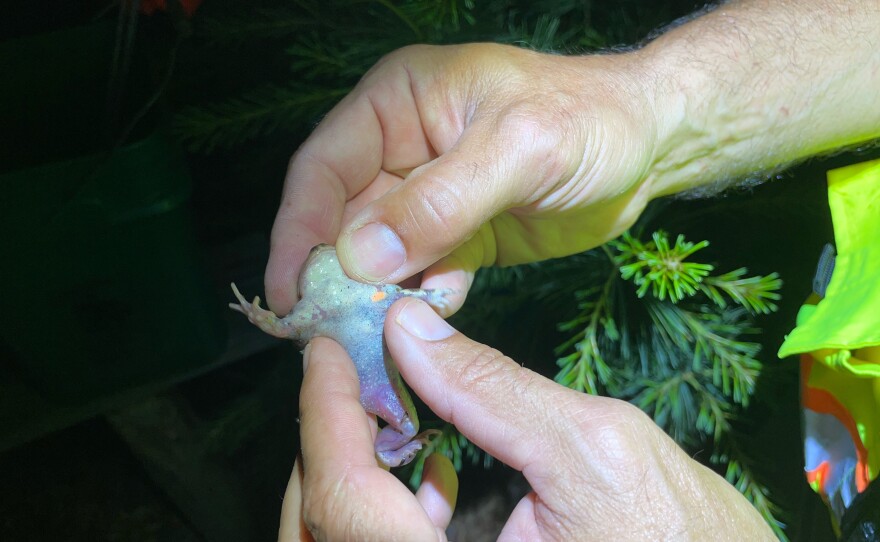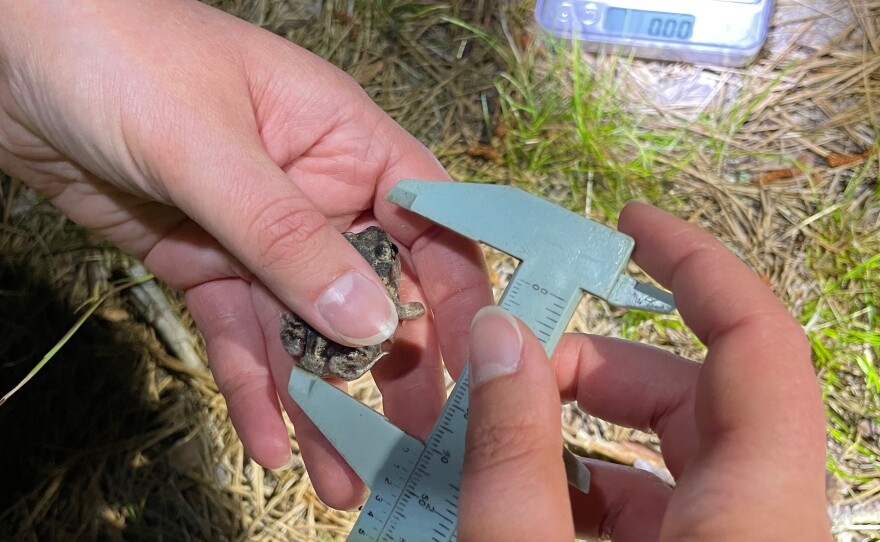Threatened toads defy odds, appear to make a comeback on the Cape

A spadefoot toad sits on a scale. Mass Audubon researchers routinely weigh, mark and measure the spadefots they fnd at Ashumet Holly Wildlife Sanctuary. (Eve Zuckoff / CAI)
In the 1980s, a rare and elusive amphibian called the spadefoot toad vanished from its habitat in Falmouth, Mass., on Cape Cod. For the last decade, conservationists have tried to bring it back. Now they believe they’ve reached a breakthrough in that quest.
The story begins each year in springtime, when Mass Audubon researchers don headlamps and scour the grounds at Ashumet Holly Wildlife Sanctuary in Falmouth for up to three hours every night, through July. The spring peepers and gray tree frogs croak loudly through the woodlands, as night after night the researchers ask the same thing: will the spadefoot toad breed tonight?
“So this project is 11 years in the making here at Ashumet Holly. The toads have bred twice — ever,” said Mass Audubon wildlife biologist and project coordinator Jay Cordeiro.
His life’s work, getting these brown, billiard ball-sized toads in the mood, is essential now. The spadefoot population is in serious decline because their breeding habitat — vernal pools — are increasingly rare.
“A vernal pool is just a temporary wetland, sort of like a pond that doesn’t last [because] it dries up,” he said. “And the reason that the spadefoots use it is because there are no fish in them. If you’re a toad and you’re going to have your babies in a pool with no predators, then you have a competitive advantage.”
Vernal pools used to be abundant, but development and climate change have upended that. And even when there are vernal pools, other challenges persist. Namely, when the spadefoot population is low, it’s dangerous for males to make mating calls.
“It’s not in their best interest to make lots of noise if they think something down here’s gonna eat them,” Cordeiro said.
In other words, if it’s more likely they’ll attract a predator than a partner, the males stay quiet. But if they don’t call, they don’t mate, and the population collapses, as happened at Ashumet Holly.
Volunteers step up to give spadefoots ‘second chance’
To bring the toads back to Falmouth, Mass Audubon started by collecting tadpoles from another site. Then the organization enlisted local children, who helped release 40,000 young spadefoots into the wild.
“Every spadefoot toad tadpole that has been raised in captivity was raised by schoolchildren on Cape Cod,” Cordeiro said. “And these kids know how to do it. We have a 95% survival ratio in the classroom.”
Plus, volunteers helped to build seven artificial vernal pools at Ashumet Holly. The pools are designed in a way to slow evaporation, so they hold water just long enough for spadefoot tadpoles to develop into toadlets, but not so long that predators have time to colonize the pools.

Mass Audubon researchers have tried a variety of techniques to mark spadefoot toads. In past years, they’ve injected a dye right below the skin, under the arm. When a light is shined on it, the color is revealed. (Eve Zuckoff / CAI)
“That’s giving these animals a second chance, because otherwise, they may just hop around here for years and end up becoming a bunch of geriatric toads who never reproduce or have any babies and just talk about their single lives at Ashumet Holly Wildlife Sanctuary,” said Cordeiro.
The work begins to work
It took 10 years for those efforts to make a difference, but finally, last summer, Cordeiro and Mass Audubon field technician Sarah Couto heard the males start to woo potential mates.
“Their mating call is … I can’t really describe it. It’s very silly sounding,” Couto said.
“I think it sounds like an upset stomach after too much Taco Bell,” Cordeiro offered.
Their indigestion-like croaks in 2021 represented a breakthrough moment for this decade-long project. But, the excitement was short-lived.
“Following the breeding event, Sarah [Couto] was here and noticed that the pool was drying and the tadpoles hadn’t developed legs or pulled in their tails yet,” Cordeiro explained, “and they were never going to make it before the water disappeared.”
The team rescued tadpoles from the vernal pool – “as many as we could before it dried” – and tried to raise them in captivity.
“We were an utter failure,” Cordeiro said. None of the tadpoles survived. “I don’t know what happened, why they all died — and they didn’t all die at once.”
Then the fear struck: what if the spadefoots’ 2021 mating event was a fluke?

Mass Audubon’s Sarah Couto measures the length of a spadefoot toad. To find these tiny creatures in the woods, she angles her head lamp, and scans side to side, looking for the glint of a toad’s eyes. “Sarah here is probably the best,” Cordeiro said. “She can spot a toad with eye shine from… 25 meters [away].” (Eve Zuckoff / CAI)
That worry was put to rest this summer when once again the males called out — and the females responded.
“So everywhere in this [vernal] pool where you see a flag is the location of a breeding egg mass that was found. One, two, three, four, five, six spots,” Cordeiro said, counting.
A few weeks later, in late June, Mass Audubon found an estimated 200-300 healthy, wild-born tadpoles. But for the second year in a row, their vernal pool home started drying up too quickly. A handful were rescued, raised in captivity, and released earlier this month. It’s likely those are the only tadpoles that survived this summer.
But Cordeiro sees this as major progress.
“Baby steps,” he said. “Baby steps. Prior to last year, no toad here had made a call in ten years. So I’m thrilled that we have had two breeding events regardless of the outcome.”
In fact, Cordeiro believes they’re just a few years away from establishing a self-sustaining colony of spadefoots at Ashumet Holly in Falmouth.
“I think we’re here,” he said. “I think going forward, this is going to be the norm here.”
